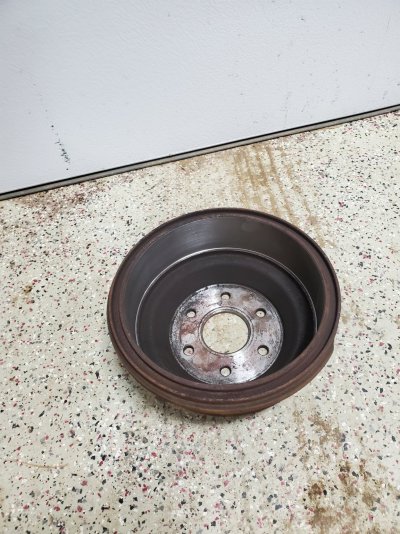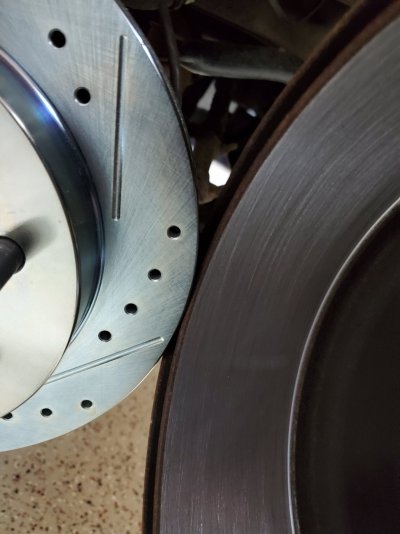Perhaps a moderator will move this thread out of the ENGINE section and into AXLES + BRAKES
Does this finish look normal after getting drums turned?
Looks rough-as-a-cob to me. I suspect that the drum was first turned with the bit travelling too fast, then the operator covered that mistake up by using coarse sandpaper to apply the "non-directional finish". Both of these operations are cost/time savings, but result in reduced quality.
I am aware that when I take photos, the photo sometimes exaggerates detail that might be hard to see with eyes in real life. So maybe what I'm seeing in the photo is not as horrible in real life.
The guy turning them broke up the "record grooving" with sandpaper or the like after he turned them.
Absolutely. The two problems are that the cut was too fast, and the sandpaper was too coarse.
the first cuts to remove material ( to get rid of grooves and out of round conditions) were faster speed. My lathe only had 2 speeds for rotors, and the slow one was for the finish cut, which should be smoother as the cutting but isn't moving across the surface as fast.
Think in terms of fine threads versus coarse threads....
YES. The groove cut on a rotor is similar to a vinyl record. The groove cut on a drum is essentially the same, starting at the inside and spiraling out to the free-end of the drum.
In both cases, the friction material will want to follow the spiral, like the tone-arm/cartridge/stylus of a record player. When the hold-down springs or pad backing plate won't allow any more movement, the friction snaps back to it's original location. Then it follows the groove again, and snaps back when it can't go any farther.
Coming to a stop results in repetitive noise as the shoe or pad pops back time after time.
Thus the OEMs want a "non-directional" "random" pattern on the braking surface of the drum/rotor, so the friction material has no groove to follow.
In addition to being "non-directional", they also want it smooth. Look at a "new" rotor or drum. They're very smooth.
Photo of "new" versus "original, worn-out" 1998 Monte Carlo rotor. Note that the old rotor got left outside overnight, it rained, the rotor rusted. It didn't come off the vehicle with rust on the braking surface.
You must be registered for see images attach
The machinist probably felt it was still too coarse a surface, so they used emery cloth on it, maybe while hand spinning the drum on the shaft?
Point to all this is, the machinist did a good job, didn't take too much out of the drum either. So you should be good to go....
I disagree. Surface finish is too rough. (Or the photo exaggerates the apparent roughness.)
The rough surface will wear the shoe and braking action may be aggressive, until the shoe wears-down the roughness. Then it'll probably be fine.
The last part of the process was to scuff the machined surface, both drums & rotors, with some 100 grit before removing the drum from the lathe. The random cross-hatching helps to seat pads & shoes against the D&R's.
There was hell to pay if I short-cutted and skipped that step.
Sort of. The "random cross-hatching" isn't intended to "help seat pads and shoes".
It prevents the repetitive noise of the shoes smacking the backing plate, or popping against the caliper after following the spiral groove of the machined surface.
D&R's don't get machined as much any more. Easier to toss & replace because of those off-shore producer's cheap-cheap prices.
That also means that they're made cheap! Recycled steel with lots of foreign matter, plus a lower nickel content than those of 30-40 years ago.
It's the nickel content that gives the steel it's strength, durability & resistance to repeated heat cycles. Without that content, the Chinesium parts don't last. Too soft. The pads & shoes eat 'em up, especially with high friction pads/shoes.
The big difference was the adoption of semi-metallic pads on "downsized" vehicles. They needed more aggressive pads to make best use of too-damn-small brake rotors. The semi-metallic pads squeaked. The iron of the rotors was DELIBERATLY softened--became sacrificial--to reduce brake squeal. This got real popular around 1980-ish.
Then the inevitable happened--rotors that were already spec'ed to wear quicker than previous designs, got Received & Duplicated (R & D) in Third World hellholes, so that the replacement rotors today are as crappy as possible.
Rotors are cast iron in most cases, not steel. Or, the braking surface is cast iron, with a steel center. If you look at the photo I posted, the original rotor is "composite"--steel center with iron braking surface, while the "new" rotor is all cast iron. The iron center is thicker than the steel original, but the lug studs are long enough that it doesn't matter. Drums are very often "composite". They take a stamped-steel center, drop it in a mold, then pour the iron braking surface around it. When the iron cools, they pull a rough-cast "composite" drum out of the mold.
Even the OEM GM-labelled D&R's are off-shore-made now-a-days.
Junk.
Yes. And buying "grooved / slotted" "ultra-premium" rotors means they take some junk "white-box" bottom-feeder rotor, spin it up on a high-speed, automated milling machine, and put the result into a four-color custom-printed box, with the decimal on the price tag moved over one place.
I'm hard on brakes. A set of the jobber rotors lasts me about 8 months. So warped, hard braking would shake the S/wheel almost out of my hands. $60.00/pair.
After 20 years of owning 400's, I've gotten pretty good at doing brake jobs on em. It was getting expensive, though.
So...I bought some aftermarket U.S. Made rotors/pads, drums/shoes. The rotors/pads were close to (!) $400.
But they lasted for 9 years. 2 sets of pads & 2 turnings.
That's less than $50.00/year.
The jobbers were costing $90.00/year + pads.
Interesting. I looked all over for quality brake iron for my various vehicles, and never found anything. Most recently, I ended up with ACDelco "Gold" made-in-China junk.
Even so, 8 months on a set of rotors seems...excessive. Sure there isn't a problem with calipers dragging? Rear brakes lasting a really long time? (i.e., front brakes overloaded because rear brakes don't work.)
Even still, no matter how much the parts cost, I always, ALWAYS, get new D&R's machined right outa the box. They go from the parts counter up front to the machine shop out back so there's absolutely no doubt.
I've had some that were so warped straight from the parts store that they could not be turned. So outa whack that by the time the surface was cut down to be nice & even all the way around, they were beyond the max cut spec.
I've returned as many as 3 sets drums & 2 sets of rotors in a row right back to the front counter before I even left the building.
When the machine shop guys brought the U.S. Made stuff back, they told me that they were damn near perfect right out of the box. They were surprised.
I take the rotors / drums out of the box, clean 'em, and put 'em on. I haven't had a problem in forever.
Truth to be told...Communist Chinese manufacturing workmanship included...I have more faith in out-of-the-box brake iron (drums and rotors) being straight, smooth, and true, than I do with most folks turning drums and rotors. It's rare to get a turned drum or rotor with the smooth "factory" surface finish.
I also test fit the brake shoes against the newly turned drums. A check to determine if the shoes need to be arced. A process that matches the brake shoe's curvature to the drum's for best contact.
Valid point, and worth looking at.
The friction will wear to the iron given some time.
Repacement shoes "should" be arced to a larger-than-stock diameter out-of-the-box to compensate for worn/refinished drums. Companies used to advertise that decades ago.
there is no meat on OEM rotors to allow turning them.
There is thickness theoretically available for refinishing.
The problem is that the iron is so soft that the braking surface is often worn beyond salvage.
I bet that pad arching process would improve a lot of GMT400 owners squishy brake pedal problem whenever that question comes up.
Ehhh. Not so much.
The usual complaint on squishy brakes is a result of air in the system, including the ABS unit; and the predictable result of the hateful leading/trailing shoe design being out-of-adjustment. Shoe arcing is a very minor issue compared to those two items. And since shoes will wear to the drum...shoe arcing is of z-e-r-o importance on shoes that aren't freshly replaced.




